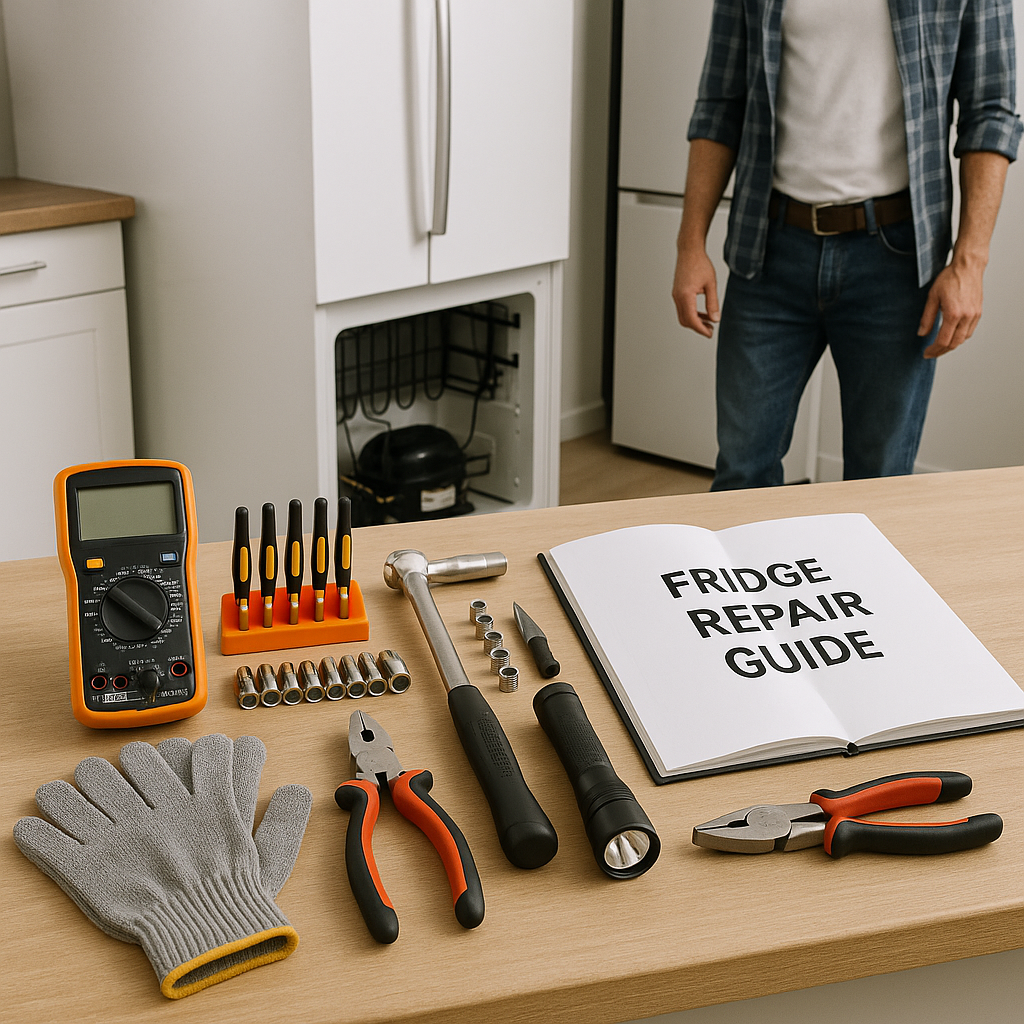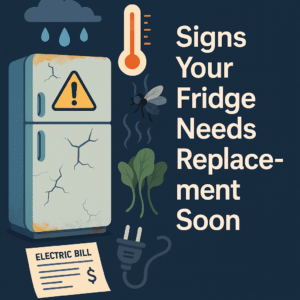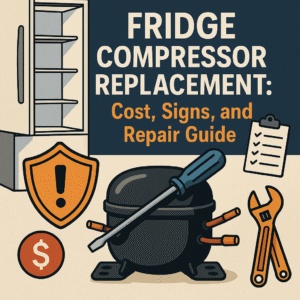Repairing your fridge at home can be a rewarding task. It saves money and gives you a sense of accomplishment. But, it requires the right tools and knowledge.
Understanding the essential tools for fridge repair is crucial. These tools help you tackle common issues efficiently. They also ensure your safety during the repair process.
DIY fridge repair is not just about fixing problems. It’s about learning how your appliance works. This knowledge can prevent future issues and extend the life of your fridge.
However, not all repairs are suitable for DIY. Knowing when to call a professional is important. It can prevent further damage and ensure your fridge runs smoothly.
In this guide, we’ll explore the essential tools for fridge repair at home. We’ll also discuss when to seek professional help. Let’s get started on building your fridge repair toolkit!
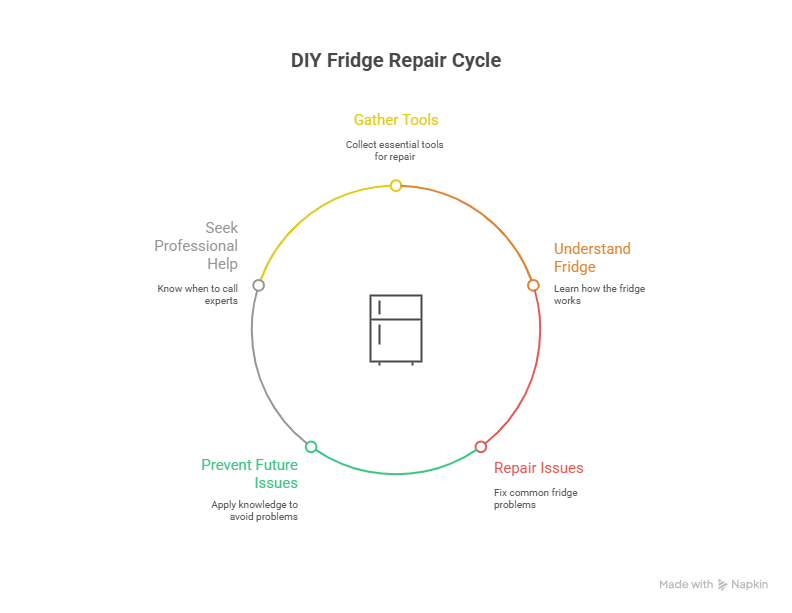
Why DIY Fridge Repair? Benefits and Considerations
DIY fridge repair has several advantages. It saves money on service fees and parts. You also avoid waiting for emergency appliance repair services.
By handling repairs yourself, you gain useful skills. These skills aren’t just limited to fridge repair. They can be applied to other home appliances too, like stoves or microwaves. Learning to fix small issues empowers you as a homeowner.
However, DIY repairs come with challenges. They require time and research to find the right solutions. You need to be patient and detail-oriented. It’s crucial to consider these aspects before starting a project.
Here are some benefits and considerations of DIY fridge repair:
- Cost-saving: Avoid pricey service charges.
- Skill development: Gain knowledge of appliance mechanics.
- Convenience: Manage repairs on your schedule.
- Risk: Potential for further damage if improperly repaired.
In conclusion, DIY fridge repair is a rewarding venture with benefits and considerations. Evaluate these factors carefully before proceeding.
Is It Worth It to Repair a Refrigerator? Complete Guide
Safety First: Essential Precautions Before You Start
Before diving into any fridge repair, prioritize safety. Without proper precautions, you might risk injury or further damage to the appliance. Awareness of potential hazards ensures a safe working environment.
Electricity is a primary concern. Always unplug the fridge before starting repairs. This simple step can prevent shocks and potential fires. Remember that even minor repairs can become dangerous without care.
Personal protective gear is also crucial. Wearing gloves and goggles keeps your hands and eyes shielded. Keep a clean workspace to avoid accidents and misplacing tools.
Here’s a quick list of essential safety precautions:
- Unplug the fridge: Prevents electrical shocks.
- Wear gloves and goggles: Protects skin and eyes.
- Keep work area tidy: Reduces tripping hazards and tool loss.
Adhering to these safety measures can make your DIY repair experience safe and effective. Always be cautious and prepared.
The Must-Have Basic Tools for Fridge Repair at Home
Having the right tools is vital for successful Fridge Repair at Home. Some tools are more essential than others. With the right set, even complex repairs can seem straightforward.
A multimeter is an invaluable tool. It checks the electrical components of your fridge. This is crucial for troubleshooting issues efficiently. Screwdrivers are another must-have. They allow access to interior components by removing panels and covers.
Pliers come in handy for gripping wires and small parts. They are versatile and aid in manipulating components during repairs. A flashlight is critical for illuminating dark areas. It ensures you can see what you’re working on, even in tight spaces.
A vacuum cleaner is not just for floors. Use it to clean dust from coils and vents. Keeping these areas clean improves fridge efficiency significantly. Having a level ensures your fridge is stable and properly balanced. This prevents doors from misaligning over time.
Here’s a quick checklist of basic tools:
- Multimeter
- Screwdriver set
- Pliers
- Flashlight
- Vacuum cleaner
- Level
Finally, it’s wise to keep a thermometer on hand. This can help verify the fridge’s internal temperature, confirming whether it’s cooling correctly. These basic tools prepare you for many refrigerator repair tasks.
With these tools, you can tackle most simple repairs confidently. Equip yourself well to maintain and repair your fridge efficiently.
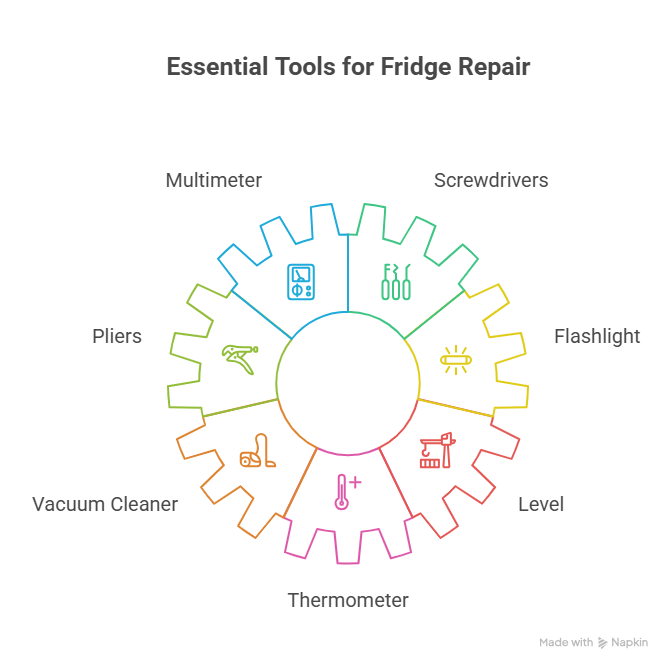
Advanced Tools for More Complex Repairs
For more challenging fridge issues, basic tools might not suffice. Advanced tools can handle complex repair tasks more efficiently. They help diagnose problems that basic tools can’t address.
A socket set allows you to remove stubborn bolts and nuts. This can be crucial when accessing deep components of the fridge. A hairdryer can be surprisingly useful. Use it to gently defrost frozen parts without damaging them.
Consider a clamp meter for measuring electrical currents. This tool is essential for diagnosing electrical issues safely. It provides accurate readings without interrupting the circuit. A stud finder might not seem necessary for Fridge Repair at Home. However, it’s useful for those integrating a fridge into custom cabinetry.
Here’s a quick list of advanced tools:
- Socket set
- Hairdryer
- Clamp meter
- Stud finder
These advanced tools can make otherwise difficult tasks more manageable. Access to the right equipment can significantly reduce repair times and improve outcomes. For those comfortable with DIY repairs, investing in these tools can be worthwhile. They prepare you for any surprises a fridge may present.
Specialty Tools for Specific Fridge Issues
Certain fridge problems require specialized tools for effective repairs. These issues can range from defrosting difficulties to water leakage.
A defrost timer tester helps diagnose malfunctions in the defrost system. This tool can quickly identify faulty timers that cause ice buildup. Water inlet valves often lead to leakage troubles. A valve core remover allows easy access for thorough cleaning or replacement.
For gaskets and seals, a gasket knife is very handy. It ensures precise replacement or removal without damaging surrounding areas. A temperature probe provides accurate readings of internal fridge zones.
Specialty tools include:
- Defrost timer tester
- Valve core remover
- Gasket knife
- Temperature probe
These tools address specific issues, ensuring targeted interventions. They can prevent small problems from escalating into major repairs. Opting for the right specialty tool saves both time and effort. Proper usage can prolong the life of the fridge, maintaining its efficiency and reliability.
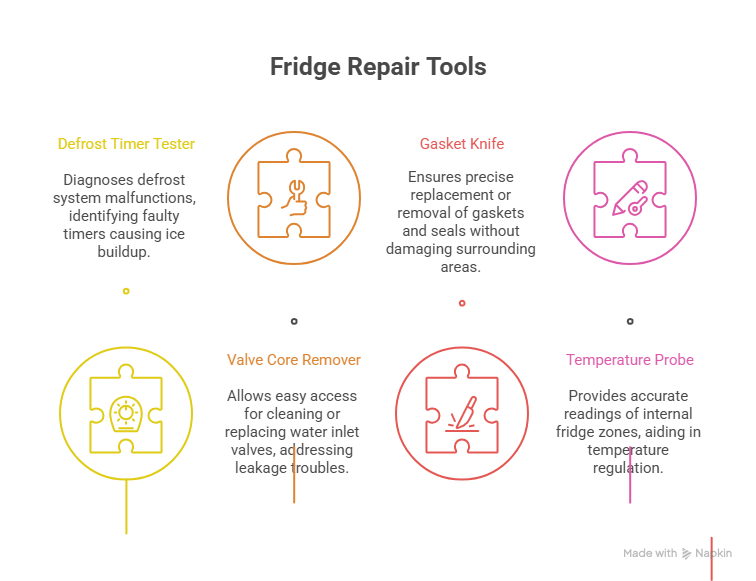
How to Use Key Tools: Step-by-Step Examples
Using tools effectively can simplify Fridge Repair at Home. A multimeter is essential for diagnosing electrical components. Set the multimeter to the appropriate setting, typically ohms, to test wires and connections. This can identify faulty elements like thermostats and relays.
Removing fridge panels often requires screwdrivers. Select the right size to avoid stripping screws. This allows access to internal components like fans and coils for cleaning or repair. Ensure you keep track of each screw’s location for reassembly.
A flashlight is invaluable for illuminating dark, hard-to-see areas. It makes identifying hidden issues easier. A bright, focused beam is ideal for examining the condenser coils or behind the fridge.
When dealing with frozen parts, a hairdryer can be quite handy. Use it to gently warm and defrost components. This reduces the risk of damage from forced removal.
Using these tools can be summarized in a few key steps:
- Diagnose with a multimeter
- Remove panels with a screwdriver
- Illuminate with a flashlight
- Defrost with a hairdryer
Learning these techniques enhances your repair skills. Practicing with tools builds confidence in handling home appliances. It can turn a complex task into a manageable one.
Common Causes of Fridge Water Leakage: Troubleshooting Guide
When to Call a Professional: Signs and Scenarios
While DIY repairs can often resolve simple issues, some situations demand expert attention. Complex electrical problems pose safety risks and should not be tackled at home. Unfamiliar components and systems may require specialized knowledge beyond typical DIY skills.
Consider calling a professional if a problem persists despite your best efforts. Advanced diagnostics by a skilled technician can offer insights that save time. It can also prevent further damage to your fridge. Moreover, repairs involving refrigerant must be handled by licensed professionals due to safety and regulatory reasons.
Here are key scenarios indicating the need for professional help:
- Refrigerant leaks
- Persistent electrical issues
- Repeated problems despite DIY efforts
Such situations highlight the importance of knowing when to consult an expert. They ensure your fridge repair is safe and effective.
Maintenance Tips to Prevent Emergency Fridge Repair at Home
Regular maintenance is key to avoiding unexpected fridge malfunctions. Consistent upkeep ensures your refrigerator operates efficiently, reducing the likelihood of breakdowns. Simple routine checks and cleanings can extend the appliance’s life.
Start with a monthly inspection of the door seals. Ensure they are intact to maintain proper cooling. Clean the condenser coils every few months to prevent dust buildup, which can lead to inefficiency.
Additionally, consider these essential maintenance tips:
- Check and replace water filters
- Inspect and clean defrost drains regularly
- Ensure the fridge is level to prevent door seal issues
- Monitor internal temperatures with a thermometer
Keeping up with these tasks can significantly decrease emergency fridge repairs. By dedicating a small amount of time to maintenance, you can save money and the hassle of unexpected appliance failures.
Frequently Asked Questions About Appliance Repair Tools
When considering DIY repairs, some common questions often arise. Many homeowners wonder which tools are essential. The basics include a multimeter, screwdrivers, and pliers. These tools cover most simple repair tasks.
Another frequent query involves the safety of DIY repairs. It’s crucial to follow safety guidelines meticulously to avoid accidents. Wearing protective gear, such as gloves and goggles, is strongly recommended.
Lastly, you may ask if specialized tools are necessary. In many cases, basic tools suffice, but specialty tools might be needed for complex problems. Here’s a quick list of frequently asked questions:
- What are the basic tools needed?
- Are DIY repairs safe?
- When do I need specialty tools?
Understanding these aspects can simplify your fridge repair experience. Equip yourself with the right tools, and tackle those repairs confidently.
Conclusion: Building Your Home Fridge Repair Toolkit
Assembling an efficient home fridge repair toolkit empowers you to handle minor issues with confidence. Start with essential tools like a multimeter, screwdrivers, and pliers. These basics provide the foundation for most repairs.
For more complex tasks, consider adding advanced tools over time. Remember, regular maintenance can prevent many problems from escalating. When in doubt, don’t hesitate to seek professional help. With the right tools and knowledge, you can manage many appliance issues effectively, enhancing your DIY capabilities and extending the life of your fridge.

